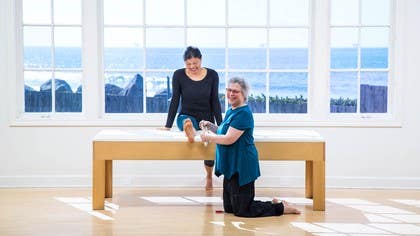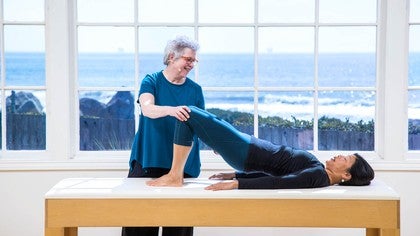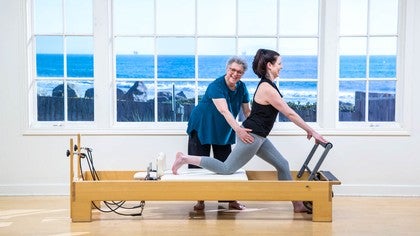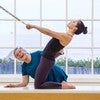Description
About This Video
Transcript
Read Full Transcript
So we're going to talk about the foot and we're going to first go through the, uh, the structures of the foot. And then we're going to go through certain muscles. We're not able to go through all the muscles of the foot. It's a very complex structure. Um, what I want you to look at is here is that tibia and there is the talus back here. That's what we know as the heel that's called the calcaneus right here is called the cuboid.
And on the inside of the foot next to the talus is the navicular. These three bones here are called the cuneiforms, the toe. This part of the foot is called the Metta phalanges and these are called the phalanges. So let's look at Michelle's foot. And here is that talus. If you go to the back, there is her cow Canus. If you go to the side of the foot, you kind of feel a little right here. You'll feel that. See that where the little toe is, there's just a little space that would be the navicular.
And then if you come on the inside, that's her, uh, right here is her key. Uh, I'm sorry, this isn't an IVIG and this is a cuboid. And then over here would be her cuneiforms. And this is her metaphor, L , Angie's, and these are her phalanges. Now you have two important arches here where the phalangeal, Metta fell Angies meet the phalanges is the transverse arch. And then where this art from the heel foot, almost up to here is called the longitudinal arch.
So we're gonna work on certain structures to help enhance the arches. So we're going to do some drawings of the lumbricals and the quadratus plantation, which are really important to strengthen these arches. So we're going to come around and she's gonna stand right there, and we're gonna do a drawing for you. So we're gonna first show you where the lumber costs are. And if we look at her foot, here's kind of where the, uh, the metal phalanges come in.
And then right here, right at that base of the toe is where the lumbricals will be ended. So it's kind of right between the fat phalanges and the metaphor phalanges. So you have, they kind of come across and they're like little lines coming up to there. And, and this is really important for training of the, um, you're this arch here. Then we're going to look at the plant, the quadratus plant.
So that attaches to the heel foot and it comes up towards the metaphor logics. So if we go here, here is the base of where their heel is and then we're going to come up this way. And that's kind of where the quadratus planted is. So I'm going to show you some exercises to help train the lumbricals and, and wake up these arches. These are fabulous exercises for you to learn as well as teach your clients because it's, we need to wake our client's feet up. It doesn't have to, it could be two, two or three reps and it will make a difference.
So the one thing I'm gonna, I'm putting my fingers here, cause a lot of times people are so tight on top of the foot that I just want to teach her that this is one of the arches and that eventually our goal is if you can see the red lines is that she wants to see, she has to slide these lines shorter. Now what's happening with her is people are very weak here. And so if my hand is my foot, she's working more from the phalanges and we need to wake up the muscles in the arches. So I want you to think about for, so right here I'm putting my fingers, can you just push right there? It's really tiny. Now she's also, she's a cheater. She's moving. If this was my ankle, she's moving from her ankle. And again, I'm just trying to move muscles in the foot vacation. And so we want her to just get this feeling and then we're going to come to there. Now if your client can do this, it's great. So we're going to have her come sitting with me, come around and take the same foot.
She's going to take her finger tips right at that place. And I want her to just see is can she push, she's having problems is she needs to get it happening right there. So what I'm trying to get her is if this is my foot, she's working up here and we want to get the, so there's the Metta phalanges and here's the phalanges. We want to get the initiation happening right there. Yes. And she, what she's doing is great because sometimes your don't understand that movement.
So her helping to learn that movement, even though she's mobilizing is really part of the process. That's better. And then she's gonna see if she can, like, if that's my fingers here, it's like my art is going to hug my fingers, our charge, our charge arch. Yes. Yes. And so this is really important for her to discover. Now just stand on your foot and feel what that feels like.
And usually what you will get a response at. Um, they'll feel their foot more grounded. They'll feel it more spacious. They might, a lot of your clients, if the this is dropped, they might feel it domain up. So, um, and it's, I'm really gonna encourage you throughout the whole tutorials is as you discover these muscle groups bring it right into standing just so that they start bringing it into their brain about how this is in their nervous system. Okay, we're gonna talk about the quadratus Planty. So Michelle, come around and we'll come look at that lower part of the foot. So this is the longitudinal arch and we'll also teach you again how to do this so the client can have homework. So what her goal is, I'm putting at the top of the foot, kind of where the those red lines and her goal is to try to bring that together again. She's doing some work at her ankle and we want her is, I want her to S that's it.
So do you see how these lines are starting to slide short? There you go. She's still doing too much work up there. That's it. There we go. So now Michelle come around again and have a seat. And you're going to put your fingertips, I put my thumb at the heel foot am two fingers at the top and your goal is to slide that shorter. There we go. And a, I'm putting my hands here and I can feel that contract. That's wonderful. Come back up to standing. Feel what that feels like.
And she'll have a, now we'll going to bring in a full foot and she'd probably feel even more grounded. And looking at our foot is she's this foot that you can start seeing the arches rising, where that left foot is a little flatter. So it's something to start building upon. So we're going to look at the muscles that go from the calf into the toes. All in.
I can't be totally anatomically correct because basically the muscles attached to the bones, but it's a great way of getting, the beauty of how this comes from the calf to the toes and was also very interesting is there's always this wonderful counterbalance in our body. So the flexor hallucis hallucis means big toe. It starts at the fibula. So it goes across and it's going to come and I'm going to just turn her ankle so that it comes around her ankle. And then it goes down through her big toe, her flexor digitorum and digitorum means digit.
So it'd be the other digits, starts at the tibia, it comes down again, it comes around that ankle, and then it goes down to all the way down to the tip of the toes. So when we did the other tutorial, we did the lumbricals, the lumbricals just came here. The digitorum goes all the way to the toes. So now we're going to look at the extensors. So let's have you come around.
So now we're going to look at the extensors of the foot, and it again starts at the calf and it's going to go down to the toes. So the extensor hallucis starts at the fibula and it goes down towards the big toe and all the extensors are going to help you with Dorsey flection. The extensor digitorum started the tibia and then it comes all the way down towards the little toes, which are called the digitorum. Now we're gonna look at ways to train the flexors and the extensors. So we're going to start training the, the flexors of the toes.
And this is some, uh, work, um, that we, I've been doing with my teach, my anatomy teacher, Irene Dowd. So the idea is that we're going to, we're going to work on the flexor hallucis first is where when she goes on her big toe, she's going to put that whole line from her calf on the stretch, and then she's going to use the box to be the load. And it's as if she's going up on our point shoe. And then her idea is to curve over something. So it's like me going stretching my big toe, I'm activating in the Essentra contraction, and then I shape it around the box or the floor to do a concentric contraction.
So let's look at, so look at here. We're gonna do the big toe and she's going to go up on her toe, and then she's going to press down as if she's going to go on a point shoe, and then she's gonna slide and go around and hug. Now let's have her do that again because this is really hard for her cause she, the hard thing is to stay long, not to just crunch the toes, but that whole line has to shape around. So go up on the big toe and then I want her to lift up and go up on that and then she's going to slide down and then she hugs. But she tries to get this whole line long and you'd have to just imagine that this line is behind her, that that this is this line right now as the extensor to go up on to train the digitorum. She's going to go up on the edges of the foot.
She's going to think she's going to go up on a point shoe, that's it. And then she's gonna drag around the box and hug it and she wants to think her toes stay long as much as she can. Let's do that again. Go up on your toes. Imagine you could stand on a point shoe on those four digits and then take it over and hug through. Now just come stand up and feel what that feels like.
And it's, it's kind of nice cause I can see that she's a little flat foot. It starting to lift that part up for her. And what's really interesting, we only did one or two reps. It can make a really big difference in your clients physicality of their feet. Now we're going to look at the extensors.
So we're going to now train the extensors of the toes. And so we want to put this on the stretch. We're going to go up on Pointe you and then we're going to scratch up the surface of, you know, it could be a wall. We're using the box, you could use your tower frame, whatever. Same thing happens in the digital form. We're going to go and put all those digits on the stretch.
We're going to imagine we're going to go up on those toes. We're going to go up some kind of surface and scratch those toes up a surface. So both Michelle and I were going to put our big toes on the floor. We're going to drag it to the box and it's like we're hitchhiking the toe up the box and we'll, let's do that again. Big toe down, up on your toe. SCRA drag across your, just a little load into the floor and a load into the box. It doesn't have to be heavy. Then you're going to go to the digit.
So you're stretching across those digits and then you're going to come up and lift those toes up. Let's do that again. You're going to come to the digits and then you're going to lift that up. Come to stand in. Feel what that feels like. What's also you're starting to train too is it's Dorsey flection of the toes, but also Dorsey flection of the ankle. And sometimes when people are so hyper extended, waking up the dorsi flexors can be really important for leg alignment.
So we're gonna look at, um, some muscles that help with the sides of the foot, the called the abductor hallucis and the add dr digitally Mininni. Now it's kind of odd. Why is it called add doctor? Because this will be the midline and it's moving away from it. So that's their logic, you know, anatomical logic, right? So what we're going to look at is the abductor hallucis attaches to the heel foot and comes across. And the same thing happens.
The abductor digit a [inaudible], uh, comes across to the little toe, especially with people with Bunyan's. A lot of that abductor hallucis is very weak. This also, this exercise that I've learned from my rain Dowd is also going to also work on the lumbricals. Um, so the goal is, is to think that you're going to bring your thought, your big toe in and then try to narrow cross and then you're going to try to bring your little toe and bring it across. I just want again, draw it for you. So here, if we look at our foot here comes the adductor hallucis over to here. And then if on the other side, the ad doctor mini me. Now the hard thing about this exercises is, uh, our clients are very weakened this.
And so they're going to use strategies to try to move the toes. So let's look at what Michelle's going to do. So she's going to try to bring her big toe to center and she's lifting up using her extensors. So one thing that I will do, and one of my colleagues had a great image is if you think your foot is in a shoe and it's a great place to do it, can you take your big toe and slide it against the side of the foot, a shoe, and then do it there. What I'm going to do with Michelle, and she could also do it on herself, I could even put a little, uh, there again, she's trying to get it across from her ankle foot and let me help you. And, and for a while, just rub your finger, just rub your finger and now just stay there.
And usually you have know, you feel your finger against your head, right? So maybe that's your beginning process with your client is just learning to, Oh, I'm just gonna put my hand lightly on. That's the beginning of some stray. So her goal is to try to sense is tied that foot and I might even mobilize her to try to get that big toe to aid add duck. Then she's going to try to bring her other toes to meet her big toes.
You could also put pencils between her toes cause she's trying to do her ankle. So come across, Oh there we go. Come and squeeze and she might not move today. Move this across and then try. You're still in. So what I'm just doing with her is I'm just mobilizing it, which is part of maybe the process because a lot of our clients are just like rocks.
They don't know that we have the same ability of movement in our hands. That can be in our feet. So that's going to be her new homework. So we're going to be talking about the calf muscles and the calf muscles attach at different portions of the calcaneus and a little bit into the cuneiforms. What's really interesting about getting these trains train is that it can help the whole Lyman of the leg. And that it's, to me, it's been really interesting having knee injuries to really get the training of the calves better has really helped my whole knee alignment.
So we're first gonna look at, and you'll notice as I draw it, it's gonna look like a stirrup because it comes underneath the foot. And so my image for my clients is can they lift both stirrups up? Sometimes you're going to have to emphasize the weaker side, um, depending on what their leg alignment. So the fibula terrace there is a, uh, a longest and a brevis the longest. They both start on the fibula, they come across right there, lift your foot up, and then it comes across down there. And right here, the brevis, the fibia, ours presence follows the same line as the longest.
Then if we look at the tibialis posterior, it comes back here up on the tibia and it comes across the foot and it comes under. So do you see how that looks like a stirrup? So now we're going to look at how to train the fibula Iris. So Michelle come up to standing and I want her to put the um, magic circle between your ankles and she can be in parallel. That's it. Come a little closer together. And usually I will have my clients, um, with their hands on the tower or the wall she can use me, especially when it comes to relevance going up on your toes.
A lot of people use momentum and I want her to feel that she's going to go straight up. So first of all she's going to do is she's going to school, ease her shins into the magic circle and then release it. And if I was to put my hands on her, she's going to get that bone rhythm of that fibula rotating outward. There we go. Squeeze. Now she's doing a little bit about her knee squeezing and I want her right where that fibula Eris. It's right on that side of the foot to squeeze in. Now let's see her squeeze in and go up on your toes.
You can use me for balance and go straight up. She's already starting to lean forward. Go straight up old. Yes ma'am. Yes ma'am. There we go. Squeeze, squeeze, squeeze. And then go back down. Now I just want to review something. She did pretty good job, but you have your, some clients are squeezing. These are my feet and they're bringing their heels together and we want it.
You know, a lot of times the shins are out. We want that outer shin to meet the magic circle. So when she goes up on her toes more and more and more. Squeeze, squeeze, squeeze, squeeze, squeeze. More, more left foot. There we go. And then come back down. And that's also going to get your client on the inside lane of the big toe.
So now we're going to look at the tibialis post here. So Michelle's going to sit down and remember it comes underneath the foot and so she wants to try to pick her R-CHOP. That's it. You could even do it a little. Lift your foot up and just try to pull the arch towards the ceiling. She's doing a little bit at her ankle foot.
And what I want her to try to do is try to pull this part of her foot up. There you go. So I'm going to draw that line again. And that's your anterior, your posterior tibialis. And that's especially if you have clients with more knock needy issues. That would be a real important training to bring about. Now we're going to look at the other calf muscles of the gastrocnemius and the soleus.
So if you could roll up your pants and I'll do a drawing. So the gastrocnemius against starts at that cow Canus it comes up and it goes right up towards the femur. There are nice juicy muscles that go up like here and then you're solely IOUs. Again, the gastric name is, you use a lot in a standing leg and your soleus, you use more when your plea aid. So that comes up just to the tibia and comes down like so now, um, I'm going to introduce the minis, which is something Maurica Molnar, uh, designed.
And if you need to want to get them with the physical mind, you can do it. We're also going to use a yoga block. If you don't have the minis now. Um, so Michelle is gonna stand on these minis and with her designer of her foot, she wants to have her ankle right over that. Please have us stand on both of them. What's neat about what um, has done is she's taken out the toes and Maurica Monarrez training the New York city ballet and one thing that the dancers are over-training, their flexor hallucis and she wants to get the um, gastrocnemius working better. Um, so right now, um, Michelle is going through some little um, reflex thing, which is really healthy for her and every time she drops her heels down is when she's letting go of that gastrocnemius okay.
If she was to do it on a block, just have one foot here. You're going to have the ball, the foot on, but your toes off. There you go. So she's going to stand on one leg and there we go. There we go. Great. And so that's the design of that. Now Michelle, I want you to come and she's going to stand with her heels here and the ball, the foot there. Yes, there you go.
Now I have a really interesting story to tell you about this is that towards the end of my dance career, my calves were seizing up and cramping all the time, so I learned this work through Maureeka and in the class, the workshop we had, the purpose of is to try to go straight up of trying to pull that heel up to to the back of the knee. That's the gastric anemias. I realize I was using the, when I went from momentum, I could feel my calves seize up. As I really learned about that gastrocnemius I had a whole different feeling about my feet. Now we're going to teach Michelle some humility. I want you to imagine there's a little man, woman, whatever you want that's going to pick your heel up a millimeter and you're going to go straight up. So be small. Lift your heels up. There we go.
And then lower down and she's going to lift up there. She's, she's having some problems. Now I want you to face the camera because I want you also to see what's happening with her sidelight. Go ahead. Sit there. Stand there. So watch her as she goes up. Go ahead, go up on her heels. Do you see how her calves go? A little bit out. So that's a little also fibula terrace weakness.
I'm going to put that between her. She's going to feel the outer shins, kiss the block, and she's going to lift her heels up and she wants to use momentum and great. Now we're going to do, this is really hard and she can use me. She's going to flex her foot. So she's gonna to work on door. No, you can take your foot off. So she's working on Dorsey flection on this leg and she's going to try to lift her heel up and may and on one side I can barely do it. There we go. Great. Good. Do the other side. So we can now you could do this standing, but it's you. And if you don't have the minis, even like if you had maybe that height, like a pump, you know he'll pump. Great. Now last thing, put both heels on.
Bend your knees and she's gonna lift her heels up. So this one will train her soleus. Lift her heels up. She's having problems. That's okay. There we go. Yep. And again, imagine that she, her shins are going out. So I want her to feel her outer shin.
Squeeze into the inner and keep there. That's it. And now Michelle come up to standing and face profile. So I'm going to show with the foot but it's kind of like Michelle is living in planner reflection at the ankle and sometimes by waking up the dorsi flexors is going to be really important. We already did uh, extensor hallucis extensor digitorum. Then you also have your tibialis anterior that comes to here. So she might even just bring her foot forward and flex her ankles, flex her ankle.
Now what's happening with her is she's going this way and so I need her to lift the little toe as much on that. It's also gonna wake up that fibrillary Iris again as well. And then she's gonna lower down and she's going to lift up, pull, pull, pull. And you can make this like, let's say you're doing legs and straps and you see your client living in the straps. This way you can have them say pull that little toe up, which is also going to work on that. Dorsey fluxion.
We don't talk a lot about Dorsey flection, but it's really important come to standing and I don't know if you can see it, but this shin is a lot more forward than that shin. So, and that's going to get her a whole different placement. And one thing is once the shin is in a different place, a healthier place, she can get to the top of her leg in a whole different way. So we're going to take all this information that we did of the foot and the calves and bring it into footwork on the reformer. So I'm going to bring all the tutorials of the feet and the calf and bring it into foot work for first going to look at the flexors, the hallucis and the digitorum.
Then we're going to look at the extensor hallucis and digitorum how to train it. So what? I'm only on to spring, she's going to push out halfway. Hold your in parallel. You want to come up on the big toe. You might even come down a bit so she can put this whole big toe on the stretch. She's going to try to keep the tip of her big toe down and lift them metatarsal head up, up.
Come on right there and then she's going to try to get that whole line to hug around that foot bar. Then she's going to come back and we're going to do digitorum. So again, I'm putting all those digits on the stretch and then she's going to lift the metatarsal heads up and then she's going to shape those toes around the foot bar. Then to do the extensors, she's going to put the big toe on the stretch and then she's going to slide the big toe underneath as if it's a peekaboo and she's pulling the foot bar with her big toe. She can even work a little bit on her ankle. Dorsey flats it. Then we're going to do the digitorum and she's going to come up on those toes and then she's going to go and you might have to knock your knee in cause I want to get the feeling of the lift of the extensors on the digitorum side and then come back in. So I've broken down footwork down a lot with my clients because I see so many problems. They push out, they hyperextend and one once they push out, the foot gets kind of rigid and they don't know how to get that big toe. So I've broken it down and so what I'm going to do is I'm going to put her heel foot on you. Can I, I'm going to use the mini today.
Depends on your client's size. You could do a small ball yoga block, probably one of the narrow yoga and I'm putting it between her ankles and she's already trying to do some things with her four foot and I want her to feel her outer ankle meet the mini. What you have to watch is are they trying to keep the mini in because they move the cow caneously in again. We want to get that outer shin going so she's going to push out. And I'm also putting my hands here to not let, that's wonderful.
And then come back in. She's doing a little work up here. Matter of fact, I'm going to ask her to dorsi flex and this is hard for her because she needs a Dorsey flex, her little toes, vivid imagination up to her hip joints. Not totally good. Even more, more there and be careful. Sometimes people are squeezing this and they're squeezing their knees together. It's just their ankles and then come back in. That's great. Good.
Now I'm gonna put, so in when we talked about the stirrups of the foot, we were kind of looking at kind of a little above the the calcaneus. So we're going to put that on the foot bar and I want her to push out. Great. She's already going into super nation. So then I want her to press and I want her to initiate from the stirrup. So where she feels the, the contact on the foot bar, she's going to press out and then she's going to press and try to lift the outer corner up. So when she, this way, that would be Tibi out and she's doing a lot of work in her forefoot then right where the um, foot bar is.
I want her to lift that outer edge up towards her hips. That was great. And that's that fibula Iris again. There we go, and that's great. Now we're going to go a little higher on her foot. So we're going to come, come, come, and we're going to put her right at the ball of the foot. Okay, now I'm wanting her to work on her. Gastrocnemius it's going to be a tiny movement.
Can she drop her heel down and she wants to do work and don't go for moment. Mobility. Go for control. She's going to pull her heel up to the back of the knee. She's going to lower one half inch down. She's going to pull her heel foot up. Thank you. That's great.
Lower your heel foot down. So that would be the gastrocnemius. She's going to play a bender. Nice. There you go. Haul without moving the carriage. She's going to lift her heel foot up to the back of the knee and then come back down. She's trying to do it from her forefoot and the soleus attaches to the heel and I want her to slide it to a shorter line and then I want her to slide it down.
Sometimes going to a muscular connection can get her better bone rhythms, so you just have to find how your client learns. So she's going to push out on a high heel shoe. Great. She's going to lower heels down. Yes. She's going to go up on a high heel shoe. She's going to bend her knees with a high heel shoe. I have principles.
I'm from, there you go. Tolleson they're coming all the way. So it's a little different. Footwork push out. This is great. And uh, that's great. And I don't know if you can see it is, she's not hyperextending how she started in the first part of the tutorial and then push out and then drop the heels down and bring it back in. So this footwork, I'm going to be bringing all these concepts into my plies reformer class at [inaudible] any time. So I hope you do all the tutorials, which will lead you into how to bring it into a class.
Embodied Anatomy: Lower Body
Comments
My irritation is that years ago I learned from M. J. Blom about the healthy bonerhythm in Plie:
Calcaneus pronates, Talus supinates ( internal rotation), and tibia internally rotates, femur externally rotates.
You need to be a subscriber to post a comment.
Please Log In or Create an Account to start your free trial.














